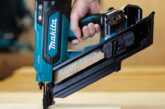
A medieval barn is being reborn as a wedding venue, and a very modern tool from Festool is proving a perfect partner.
In the restoration of an ancient structure there is often an element of detective work – peeling back layers of history in a forensic process of examination to uncover just what the craftsmen of the past had originally undertaken. That’s just what Tom Massey and his expert team from Dolmen Building Conservation are doing at the restoration of a 15th-century barn in Rochester, and his Festool 18V OS 400 Multitool is a vital weapon in the battle to raise this fire damaged Grade 1 listed building from ruin.
“Multi-tools have really revolutionised the way we work on projects like this one,” says Tom. “It means we can more precisely cut out damaged and rotten timbers whilst leaving as much of the original structure intact as is possible, but the Festool example comes with a few features I’ve never seen before. The OSC-AH Positioning Aid, for example, provides a guide along a mark, helps keep you square, and stops the blade from wandering as it might if you were plunge cutting freehand. It works almost like a jig on a router and, when clipped into place, can be turned in either direction and set in different positions, and that’s also helped with the construction of some of the joints here.”
Despite its status as a building of national importance, Frindsbury Manor Barn has been derelict since the 1970s. A number of fires have subsequently weakened some of the rafters, whilst in the worst of the conflagrations four of the structure’s bays were completely destroyed. Tom and his team are tasked with completely rebuilding the far end with locally sourced oak, a job which has also revealed some of the carpentry techniques of the original medieval builders. “We’ve found some very unusual joints on this job,” says Tom, “and we’re copying them all like for like, which has been a challenge. It’s on jobs like these that you gain real respect for the original carpenters because they’re using basic hand tools like axes, whilst we’re replicating the curved braces and tie beams with bandsaws, and the joints with the help of the Festool Multitool.”
This 210ft-long tithe barn was used to store the produce collected by the wealthy clergy of nearby Rochester Cathedral, but still contains its own riches for its restorers in the story it reveals of old building techniques. The intricate stop-splayed splinted abutment joints much in evidence in the barn’s roof timbers, for example, would now be a lost art to the modern chippie, but were a vital skill to their forbears in the 1500s, providing the necessary strength in the rafters centuries before the advent of stainless steel fixings. These are joints that even an experienced restorer like Tom has never previously encountered and has been using the OS18, and its positioning aid, to recreate that complicated carpentry.
It is, in fact, the addition of a magnet on that Positioning Aid that draws the blade towards it and keeps it in position when cutting, preventing any front to back movement but still allowing oscillation, but the benefits don’t end there. The Festool Vecturo OS18 Multitool is designed to be a woodworker’s friend, with a number of features that should save time and ensure a better finish. With the StarlockMax tool holder there’s no need for tools to change the blades – just release a lever and they will clip in and out. The tool is also equipped with a dust extraction device, whilst a variable speed control keeps the end user in complete control and, as Tom was ably demonstrating on this substantial barn repair, the brushless EC-TEC motor has the grunt to make its way through some quite substantial oak boards. “Quite often full speed can often be too powerful, but having the ability to adjust it means you can carry out some quite fine undercutting work. Not only that but the OSC-TA depth stop means you can plunge cut quite accurately as well.”
“The tool sits very neatly in the hand and is lightweight enough to be comfortably used all day. Because we use multitools a lot I’ve owned at least three different brands over the years, and the 18V battery on the Festool sits in the tool more comfortably, with a more streamlined designed. That’s important because I’ve seen some cordless examples that can be quite chunky and cumbersome. At Dolmen Building Conservation we’ve worked on some very prestigious projects – at Canterbury Cathedral and Westminster Hall, for instance – and without a Multitool like this Festool we just couldn’t carry out the kind of sensitive repairs that these projects deserve.”
![]()







